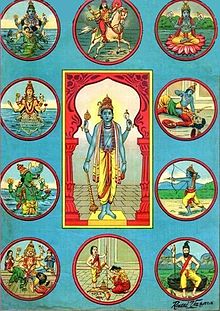Our website is made possible by displaying online advertisements to our visitors.
Please consider supporting us by disabling your ad blocker.
Dashavatara

| Part of a series on |
| Vaishnavism |
|---|
 |
The Dashavatara (Sanskrit: दशावतार, IAST: daśāvatāra) are the ten primary avatars of Vishnu, a principal Hindu god. Vishnu is said to descend in the form of an avatar to restore cosmic order.[1] The word Dashavatara derives from daśa, meaning "ten", and avatāra, roughly equivalent to "incarnation".
The list of included avatars varies across sects and regions, particularly with respect to the inclusion of Balarama (brother of Krishna) or Gautama Buddha. In traditions that omit Krishna, he often replaces Vishnu as the source of all avatars. Some traditions include a regional deity such as Vithoba[2] or Jagannath[3] in penultimate position, replacing Krishna or Buddha. All avatars have appeared except one: Kalki, who will appear at the end of the Kali Yuga.
The order of the ancient concept of Dashavataras has also been interpreted to be reflective of modern Darwinian evolution, as a description of the evolution of consciousness.
- ^ "Know About 'The Dashavatara'~ 10 Avatars of Lord Vishnu in Hinduism". NewsGram. 5 June 2020. Archived from the original on 27 July 2021. Retrieved 18 February 2021.
- ^ Cite error: The named reference
maharashtra.gov.inwas invoked but never defined (see the help page). - ^ Leyden 1982, p. 22.
Previous Page Next Page


